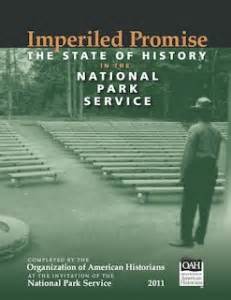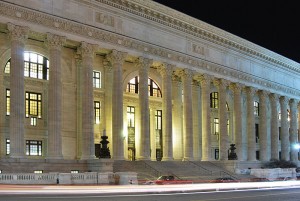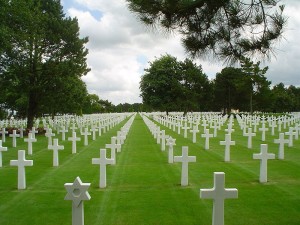
After all the surveying and analysis as described in two previous posts, the authors of the study Imperiled Promise: The State of History in the National Park Service turned to the recommendations to alleviate the situation. As one might expect they called for the NPS to recommit to history as one of its core purposes and to adhere to the “best available sound history scholarship as a standard of quality for the NPS history.
They proposed 12 approaches to historical research to be discussed nationwide throughout the NPS.
- Expand interpretive frames beyond existing physical resources
Any physical site including its physical resources is only a remnant of a disappeared past. Furthermore historical research may uncover stories not directly represented among the physical objects which by chance happened to have survive. Tell the big story.
- Emphasize connections of parks with the larger histories beyond their boundaries
No site is an isolated island whose stories are limited to the physical space set aside by law. Learn the connections and include them in the story of your site. I will add that tourists may already make such connections in their itineraries whereby they visit multiple locations during their vacation.
- Highlight the effects of human activity on “natural” areas
Integrate nature and culture. Natural areas or landscapes may have been shaped by human activity. I will add that representations of natural areas also may obscure the human activity which shaped. Human activity shaping the landscape did not begin with European settlers. Leave the two-dimensional clichés to Disney. Tell the stories of real people.
- Acknowledge that history is dynamic and always unfinished
For example the male white (English) Harvard New England historians of the 19th century tended to privilege the role in the American Revolution of male white New Englanders in their writings and scholarship. Both New York and the South were shortchanged as well as other ethnicities, races, and genders. In another example, ten years ago how many high school students had even heard of Hamilton? The more people want to be part of the story of the American Revolution, the stronger the United States becomes. I don’t know if every immigrant to England, France, and Germany connects with William the Conqueror (or King Arthur), Charlemagne (or Napoleon), Frederick the Great (or Bismarck), but every American can connect with some figure in the American Revolution. History grows when it is alive and part of our journey as a country.
- Recognize the NPS’s role in shaping every park’s history
Those who tell the story become part of the story because of what they choose to tell. I will add, should every guide at a single site tell the same story? Given that not everything can be communicated in a single tour, why should every tour be the same? The visitors too have different interests. For example as part of two conferences, I recently visited the Oriskany Battlefield twice. We had the same NPS Ranger guide. For the American Revolution in the Mohawk Valley conference, he spoke about the battle; for the Erie Canal Bicentennial conference, he spoke about the stones from the nearby canal being used to construction the monuments at the battle site. Let’s recognize the different aspects of the story at a site and allow visitors to have some control over what they will experience.
- Attend to the role of memory and memorialization at historical sites.
“Rather than freezing an event depicted at a park or site as something that happened in the past, history interpreters should acknowledge and investigate the diverse and changing ways (and reasons) that people have remembered and assigned significance to that event or place (up to and since the when the park itself was designated “historic”). I will add, fossils (of dinosaurs) do have an appeal, but an immersion into history provides a more vibrant memory for the visitor.
- Highlight the open-endedness of the past
“Rather than cloaking historical outcomes with a gloss of inevitability, history interpreters might pry open past events to reveal the many viable alternatives a multitude of past actors faced as they struggled to solve actions, take actions, and frame horizons.” I will add, suppose William Johnson had lived throughout the American Revolution instead of dying in 1774? Suppose slavery had been the deal-breaker that prevented the United States from constituting itself as a country in 1787, then what?
- Forthrightly address conflict and controversy both in, and about, the past
Scholars disagree. Do visitors know that? For the NPS with its many Civil War sites, this admonition can be a real challenge especially with all the talk today about memorials, statues, and street names.
- Welcome contested and evolving understandings of American civic heritage
This recommendation seems like a variation of the previous one. The civic aspect is crucial.
- Envision “doing history” as means of skills development for civic participation
Tours tend to teach details not skills. Tours tend to provide small-bore facts that are quickly forgotten. Quick, which painting is of the second son of the patriarch and what is name of the woman he married on the painting next to him? As I worked my way through this list of recommendations, I realized, as you readers may have, that many of these recommendations are more suitable for a classroom, i.e., an air-conditioned setting where people are sitting down for up to 30-45 minutes as in a public lecture, than to an outdoor or non-airconditioned indoor setting where people are standing and on the move. Perhaps it should be no surprise that the consultants, professors obtained through the auspices of the Organization of American History, would tend to recommend replicating the ideal classroom setting without taking into account the practicalities of the visitor logistics and expectations.
- Share authority with and take knowledge from the public
Again this recommendation seems like a variation on a theme and one more appropriate to the classroom than the guided tour. If these conversations are to occur in an academic setting such as a ranger attending a history conference, then such exchanges are worthwhile and one of the purposes of a history conference. If these conversations are to occur during a guided tour then it seems more reminiscent of having a discussion with a loudmouth know-it-all who could dominate the tour if left unchecked. Exactly what are the venues where these conversations with the public are supposed to occur? Typically guided tours are not conducive to such exchanges with the general public but can work with a controlled group such as teachers.
- Better connect with the rest of the history profession and embrace interdisciplinary collaboration
By this the authors specifically mean NPS historians should have ongoing relationships with public history sites, academia, and k-12 education. I interpret this to mean in part attending the national and state history conferences of various organizations, attending the history conferences about related subjects, attending social studies conferences.
Collectively, these recommendations certainly present a positive vision of history at history sites. My questions and concerns are where the rubber hits the road. Exactly how are these recommendations to be implemented? What do they really mean on the frontlines where the worlds of the tourist visitor and the Park Ranger intersect? Since historic sites are not cookie cutter facilities, what do they mean in the different settings? How are Park Rangers to be trained to do what the recommendations suggest?
Ironically, the tourist visitor already has implemented some of these recommendations. When tourists plan a vacation trip, they select the places they intend to visit. In other words, they are positioning an historic site within a host of places in their one-week vacation. In so doing, they are making connections to other venues, not all necessarily historic, as they schedule their trip.
Sometimes the geographic range of the associated sites to a NPS historic site may be quite extensive. Think of the Civil War battlefields as the most obvious. Sites also may be connected to state, county, local, and private sites as well in the event covered or the person/people who lived at the NPS site. This means cooperating and collaborating both within the NPS especially across thematic lines and with external organizations. Is there a mechanism to do that?
There are a wide range of facilitates within the NPS umbrella. Some would find it easier to comply with these suggestions than others. For example in New York, there is a giant FDR and Eleanor Roosevelt complex in Hyde Park including grounds, multiple structures, a presidential library, and a visitor center thanks in part to Friends with Benefits. I have conducted week-long Teacherhostel/Historyhostel at the site combing NPS and non-NPS presenters, tours, and walks. People can spend a day there on their own and the site has its own cafeteria. This site has the size to implement the recommendations if it hasn’t done so.
On the other hand, there is nearby St. Paul’s Church, scrunched into a now-commercial area in Mount Vernon. The site is owned by the NPS but operated by a private group. Its friends group doesn’t begin to compare to that of the Roosevelts. It lacks the space of the larger Roosevelt site. Its lectures are in the unairconditioned church itself where we sit in the colonial church pews. Quite a different experience. Although I park often by Grant’s Tomb by the Hudson River near Riverside Church in Manhattan, its setting in a plaza makes it a stop on the gazillions of bus tours “doing Manhattan.” It really is a tomb. People take their pictures and then it is on to the next non-NPS site which has nothing to do with Grant. How should these sites implement the recommendations?
Before continuing to exam Imperiled Promise, I suggest certain actions to be taken which would benefit not only the NPS but the history community in general.
1. Workshops on recommendations of Imperiled Promise to be held in the primary NPS areas in New York such as New York City, Hyde Park, Saratoga, and Rome.
2. The workshops to be open to non-NPS sites including the NYSOPRHP sites. As an example, the NPS has a site at Fort Stanwix in Rome, it operates the aforementioned Battle of Oriskany site for the NYSOPRHP which owns it. NYSOPRHP also owns and operates nearby the home of the commander of the American force, Palatine General Herkimer (but without a site manager). Then there are related non-government sites like Herkimer’s Church and the Shako:Wi Cultural Center of the Oneida who supported the American side in this America Revolution battle. The division of the Haudenosaunee into competing sides for one tribe fought another had lasting effects to this very day. Look how much is missed if only one site is visited or if the separate sites do not function together.
Imperiled Promise isn’t only a wakeup call to the NPS to get its history act together, it’s a call to the entire history community. Is anybody listening?











